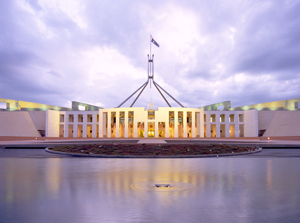Each year, about one million people visit the building which houses the Parliament of Australia. This large structure sits at the apex of Capital Hill in the centre of Canberra—Australia’s national capital. The building was designed by architects Mitchell, Giurgola and Thorp, and opened in 1988. The flagpole that straddles the building has become a symbol of the Parliament and of Canberra.
Parliaments are unique. They are not like office blocks or law courts or convention centres. A parliament must do four basic things and the building must be designed to allow these four things to happen. The members of a parliament
must be able to:
1. represent people
2. make laws
3. scrutinise the government
4. form a government from elected parliamentarians.
Australia’s modern Parliament House was planned to facilitate these functions. All four functions of parliament take place in the House of Representatives and Senate chambers as well as other rooms. There are many other activities that take place in the federal Parliament such as radio and television broadcasting and printing reports and other documents.
How the Parliament uses the building
This diagram of Australia’s Parliament House shows its scale and the relationship between the parliamentary, executive, ceremonial and public areas. The building is 300 metres wide, 300 metres long and covers a gross floor area of 250,000m2. Massive curved walls separate and define the major component parts. The House of Representatives wing is on the eastern side with the Senate chamber and offices to the west. The executive wing is at the southern end of the structure, behind the ceremonial and public spaces of the central zone.
The chambers
The dominant spaces across the whole building belong to the House of Representatives and Senate chambers where members and senators meet to debate bills and represent the people from their electorates and states. The Australian Government is formed in the House of Representatives by determining the party or coalition of parties that hold the majority of seats and which therefore has the largest number of members. Opposition parties in both chambers scrutinise the work of the government especially during regular Question Time sessions.
The House of Representatives currently seats 150 members and there are enough unused seats to accommodate future increases. The Senate currently seats 76 senators, and like the House of Representatives, has vacant seats to accommodate future needs.
In both chambers:
- Members of the government sit to the right of the Speaker or President (as the case may be) while members of the opposition sit to the left.
- Members of minor parties (such as the Australian Greens and the Family First Party) and Independents sit on the benches at the curve of the chamber. This group is known as the crossbench in the Senate; in the House this distinction is not made—there are only government and non-government members.
- The press gallery views chamber proceedings from above the Speaker's Chair in the House and from above the President's Chair in the Senate.
- Members of the public watch chamber proceedings from either side of the chamber in designated seating areas.
Parliament House contains 19 committee rooms. Although these rooms are formal parliamentary spaces, they are not used for debating or voting on legislation. A parliamentary committee is comprised of a small number of parliamentarians with a specific task; generally to gather information (on behalf of the Parliament) related to a current legislative proposal or an issue of community concern. Both the Senate and the House of Representatives employ a range of committees. This photograph illustrates a Senate committee in action. The senators are sitting in the background; members of the public observing the proceedings are in the foreground and one man at the centre of the scene is giving evidence to the committee. Technicians sitting In the glassed-in control room switch on microphones and record the discussions. Note also, the television cameras which are installed in spaces in the walls of the committee room.
Cabinet Room
Cabinet usually meets in the Cabinet Room in Parliament House. The Cabinet is the centre of executive government. It is responsible for managing the policy directions and business of the government. Cabinet is chaired by the Prime Minister and operates as a sub-committee of the ministry.
The Cabinet Room is located on the ground floor in Parliament House opposite the Prime Minister’s office and close to the offices of the other ministers. Marquetry panels of eucalypt leaves designed by artists Tony Bishop and Michael Retter adorn the room. Hidden among the leaves is a cicada, a dragonfly and a blowfly. Despite these ‘bugs’ the room is highly secure and is regularly swept electronically because the Cabinet discusses confidential and secret matters that affect the life and well-being of the nation.
Facts about the building
- The Parliament House site covers 32 hectares of Capital Hill; one of the hills around which Walter Burley Griffin designed Canberra in 1912. The building occupies 15 percent of this site.
- The building is 300 metres long and 300 metres wide. It is one of the largest buildings in the southern hemisphere.
- Parliament House was built to last at least 200 years.
- There are 8,340 spaces in the building including about 4,700 rooms and 2,700 clocks.
- Australian materials are used throughout 90 percent of the building.
- The building cost approximately 1.1 billion dollars.
- The underground car parks hold up to 2,000 cars.
- A multi-channel television and radio station broadcasts proceedings of the Parliament from both chambers and committee rooms.
- The building has two libraries; one a reading library, the other a research library for the benefit of answering questions on most topics from members and senators.
- The Parliamentary Education Office runs a parliamentary role-play program for visiting students and teachers to learn how the Parliament works.







No comments:
Post a Comment